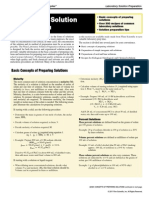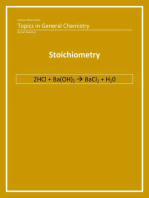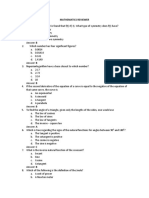MLAB 2401: Clinical Chemistry: Chapter 3: Basic Principles and Practice of Clinical Chemistry, Part 1
Uploaded by
Ellen Castillo MarianoMLAB 2401: Clinical Chemistry: Chapter 3: Basic Principles and Practice of Clinical Chemistry, Part 1
Uploaded by
Ellen Castillo MarianoMLAB 2401:
Clinical Chemistry
Chapter 3: Basic Principles and Practice
of Clinical Chemistry, part 1
UNITS OF MEASURE
Measurement requires a numerical value and a unit
SI units:
length ( meter )
mass ( gram )
quantity ( mole )
Volume ( liter )
Time ( second )
Basic units describe unrelated physical quantities
Laboratory results almost always have units of measurement associated
with them
Unit of Measure: Prefixes
Common prefixes that are added to units of measure:
deci (d)
10-1
centi (c)
10-2
milli (m)
10-3
micro ( )
10-6
nano (n)
10-9
pico (p)
10-12
femto (f)
10-15
Example: A common unit of liquid measurement is a deciliter( dl ), or one
tenth of a liter
Combine a prefix with a basic unit results in a statement of a specific length,
weight or volume
Reporting clinical chemistry results may be in units such as :
mg / dL
g / dL
mEq / L
3
Conversions
Most conversions within the metric system occur in units of TEN
where changing a unit of measure to a higher or lower designation
requires moving the decimal one place either to the left or to the
right.
When converting measures in either the high end of the scale
(example kilo to mega) or the low end of the scale (examples milli to
micro, micro to nano, etc.) the decimal must be moved three places
right or left as the prefix designations are assigned only to every
third unit in the extreme ends.
Example of a conversion
How many mls are there in 2.5 liters?
The question you have to ask yourself is, what is the relationship between
liters and mls? The answer : 1 liter = 1000 ml
But now what?
We want to get rid of the liters units and end up with mls Right ?
1000 mls
2.5 Liter
2500 mls
1 Liter
1.25 liters = _____ mls ?
Remember, write a fraction that does two things:
1. Equals 1
2. Gets rid of unwanted units and / or adds needed units
1 0 0 0 m ls
1 . 2 5 L i t e r s 1 L i t e r 1 2 5 0 m l s
100 mg =
_________ ug ?
1000 ug
1 0 0 m g 1 m g 1 0 , 0 0 0 0 u g
6
Another conversion example
Physiological Saline is used in Blood Banks and Hematology to prepare
Red Blood Cell suspensions.
Physiological Saline is usually listed as being 0.9 % NaCl
0.9 grams of NaCl is added to 100 mls deionized water to make
physiological saline
What is the Normality (N) of physiological saline?
0 .9 g r a m s N a C l 1 E q W t N a C l 1 0 0 0 m l s
0 .1 5 N
1 0 0 m ls w a te r 5 8 g r a m s 1 L ite r
Unwanted units cancel out
leaving EqWt / Liter = N
Fraction = 1
Fraction = 1
Conversions are manipulations of the units not the values !!!
7
Scientific Notation
True scientific notation format:
1.22 X 104
BUT in hemo, for example a hemoglobin result
would look like = 12.2 X 103
Temperature
Scientific measurement of temperature is always expressed in the Celsius ( C) scale ,
not Fahrenheit ( F )
Measurement of temperature is an important component of the clinical lab.
Instruments, refrigerators and incubators are required to operate within specific
temperatures that must be maintained and monitored.
Each laboratory must have a NIST calibrated thermometer in order to ensure the
accuracy of other thermometers in the laboratory
Celsius scale:
0 degrees = freezing point of water
100 degrees = boiling point of water
Conversion of Celsius to Fahrenheit and Fahrenheit to Celsius
F = ( C x 1.8 ) + 32
C = ( F - 32 )
1.8
Conversion: Temperature
Conversion of Celsius to Fahrenheit and Fahrenheit to
Celsius
F = ( C x 1.8 ) + 32
C = ( F - 32 )
1.8
For example:
Your refrigerator at home is probably around 40 F. What is that in Celsius?
Celsius= 40-32 = 4.4
1.8
Water boils at 100 C. What is that expressed in Fahrenheit?
F a h r e n h e i t 1 .8 1 0 0 3 2 2 1 2
10
Solutions
The clinical lab almost always uses solutions. A solution means that
something has been dissolved in a liquid. In the clinical laboratory the
solvent we measure most of the time is human plasma. The solute is
whatever the substance is we want to measure.
Mixtures of substances the substances in a solution are not in
chemical combination with one another.
Dispersed phase - the substance is dissolved (the solute)
The substance in which the solute is dissolved is the solvent.
Solute + Solvent = Solution
11
Concentration
Concentration refers to the amount of one substance relative to the
amounts of the other substances in the solution.
Expressing Concentration
Percent solution (parts/100)
% w/w percentage weight per weight
% w/v percentage weight per volume
Easiest & most commonly used, very accurate if temperature controlled.
Example : mg/dL
% v/v percentage volume per volume
Most accurate method of expressing concentration, but can be cumbersome (especially with
liquids), not often used in clinical labs.
Example :mg/gm
Least accurate, but used when both substances are liquids
Example : mL/L
Note: volumes of liquids are not necessarily additive.
12
Solution Properties
Concentration can be measured in many different units
% Solutions: w/w, v/v , w/v (parts of solute / 100 totals parts )
Note: liquids + liquids and solids + solids alters the total parts,
but solutes + solvents does not
Molarity: Moles / Liter
Molality: Moles / 1000 grams solvent
13
What is a Mole?
Mole = 6.022 X 1023 number of atoms or
molecules
Molecular Weight
The molecular weight( MW ) of hydrogen = 1.0
That means that 6.022 X 1023 hydrogen atoms weighs 1.0 gram
The MW of H2O = (1)(2) + (16) = 18
1 mole of water weighs 18 grams
That means that 6.022 X 1023 H2O molecules weigh 18.0 grams
14
Solution Properties
Normality (normal solutions): Equivalents Weights
/ Liter
Working with normality, is most important when
dealing with acid or bases in neutralization reactions.
Equivalent Weight = MW / Valence
Valence = the electrical charge of an ion, or the
number of moles that react with 1 Mole H+
15
Equivalent Weight
Equivalent Weight = Molecular Weight / Valence
The valence is the electrical charge of the substance
1 Equivalent weight of any substance reacts with 1 Equivalent Weight
of hydrogen ions
Example
The MW of calcium = 40 grams
Calcium ions carry a +2 electrical charge ( valence = 2 )
Equivalent Weight of calcium = 40 / 2 = 20 grams
16
Solution Properties
Normality
N = M x valence
M = N / valence
M is always < N
Calculation tips
Use ratio and proportion when NOT changing concentration.
For calculations changing concentrations (as in titrations), use:V1C1
= V2C2
Important to remember that you cannot make a solution more
concentrated.
17
Solution Properties
Titration Method of measuring concentration of one solution by comparing
it with a measured volume of a solution whose concentration is known
General formula: when you have a volume and concentration of one,
and either the volume or the concentration of the other: V1 C1 = V2 C2
For Example:
How many mls of 1.0 N HCl is required to prepare 25 mls of 0.5 N HCl ?
( 1.0 N ) ( ? mls ) = ( 0.5 N ) ( 25 mls )
? mls = 12.5 mls
You would need to add 12.5 mls of 1.0 N HCl to 12.5 mls of deionized water
( a total volume of 25 mls ) to prepare 25 mls of 0.5 N HCl
18
pH and Buffers
1
H
Buffers resist change in acidity
Buffers are usually weak acids ( or bases) and their salts
pH is the unit used to measure acidity ( Hydrogen ion concentration )
p = negative log of the concentration of a substance in solution.
Example: pH = - log [H+]
The Hydrogen ion concentration of deionized H 2O is 1 x 10-7 M
The negative log of 10-7 = 7. The pH of H2O is 7.0
The pH scale ranges from 0 - 14
pH 7 = neutral
pH > 7 = alkaline (basic)
pH < 7 = acid
19
Dilutions
A ratio of the concentrate to the total (final) volume.
A 1:4 dilution has a 1 volume of sample and 3 volumes of diluent mixed
together.
Any volume can be used to create this dilution, but it must be
the same unit of volume
Keep in mind the sample size when making your dilution
For example: a 2:3 dilution could contain:
2 mL serum: 1 mL pure water
20 L of serum: 10 L of pure water
0.2 mL of serum: 0.1 mL of pure water
20
Dilutions
Find the dilution factor:
0.1 mL serum
2.9 mL DI water
1.0 mL reagent A
1.0 mL reagent B
5.0 mL total volume
0.1 mL serum
5.0 mL total
=1
X
X = 50 (that is the dilution factor)
Dilution is 1/50
21
Examples of dilutions and dilution factors
Parts
Specimen
Parts
Diluent
Total
Volume
Dilution
Dilution
Factor
1.0
1.0
2.0
1:2
1.0
2.0
3.0
1:3
1.0
3.0
4.0
1:4
1.0
9.0
10.0
1 : 10
10
0.5
4.5
5.0
1 : 10
10
0.2
1.8
2.0
1 : 10
10
0.2
9.8
10.0
1 : 50
50
22
Serial Dilutions
In these types of questions, you are given a series of tubes.
Each tube having a measured amount of a diluent.
You are instructed to add a specified amount of specimen into the first
tube, mix well and transfer a specified amount of the mixture to the next
tube, etc.
23
Serial Dilutions
Example:
6 tubes, each with 0.5 mL DI water
Add 0.2 mL serum to first tube and serially dilute
Find the dilution in tube # 6
Find the dilution factor (will be the same in each of these tubes)
1/dil factor x 1/dil factor x 1/dil factor (etc. 6 times)
Result multiplying the numerator 1x1x1x1x1x1x1x = 1
Multiplying the denominators
Will give the result as 1 / 838
24
Resources
http://www.youtube.com/watch?
v=ZqdU3VfQ_Tc
25
Solution Properties
Density An expression in terms (usually) of
a mass per unit of volume
Many examples - including specific gravity,
osmolality
26
Water Specifications
Tap water is unsuitable for lab use (too many impurities)
Types of water purification techniques
Reagent Grades of water
Distillation removes most organic matter
Reverse osmosis
Filtration
Deionization ions removed
Type I Purest Required for sensitive tests
Type II Acceptable for most uses
Type III OK for washing glassware
CAP - QC of water : pH, electrical resistance, bacterial culture
27
Water filtration system for
Automated chemistry analyzer.
28
You might also like
- Volumetric Analysis: The Equipment The Terms The Process CalculationsNo ratings yetVolumetric Analysis: The Equipment The Terms The Process Calculations27 pages
- Concentration Expressions Serial DilutionNo ratings yetConcentration Expressions Serial Dilution34 pages
- How To Make Simple Solutions and DilutionsNo ratings yetHow To Make Simple Solutions and Dilutions12 pages
- Preparing Laboratory Solutions and ReagentsNo ratings yetPreparing Laboratory Solutions and Reagents61 pages
- Exercise-No-3-Docx 74d033c95f9123e41bdb02298cf5b 240911 185708No ratings yetExercise-No-3-Docx 74d033c95f9123e41bdb02298cf5b 240911 1857085 pages
- Understand Concentration Units & DilutionsNo ratings yetUnderstand Concentration Units & Dilutions3 pages
- Concentration Units and Comparison of Concentration UnitsNo ratings yetConcentration Units and Comparison of Concentration Units8 pages
- No Nonsense Pool Care: Yes, You Can Take Care of Your Own PoolFrom EverandNo Nonsense Pool Care: Yes, You Can Take Care of Your Own PoolNo ratings yet
- The Chemistry of Dairy Products - A Chemical Analysis of Milk, Cream and ButterFrom EverandThe Chemistry of Dairy Products - A Chemical Analysis of Milk, Cream and ButterNo ratings yet
- Review Question For Comprehensive Exam in BBNo ratings yetReview Question For Comprehensive Exam in BB6 pages
- Industrial Fault Indication System With Over Voltage Over TemperatureNo ratings yetIndustrial Fault Indication System With Over Voltage Over Temperature46 pages
- Math For Real LifeTeaching Practical Uses For Algebra Geometry and Trigonometry100% (1)Math For Real LifeTeaching Practical Uses For Algebra Geometry and Trigonometry213 pages
- Disclosure To Promote The Right To InformationNo ratings yetDisclosure To Promote The Right To Information12 pages
- Chapter 5 - The Gas Phase List ALL Basic QuestionsNo ratings yetChapter 5 - The Gas Phase List ALL Basic Questions45 pages
- Melting Point Apparatus: Mel-Temp and IA9000 SeriesNo ratings yetMelting Point Apparatus: Mel-Temp and IA9000 Series6 pages
- Review Notes in Fire Technology and Arson InvestigationNo ratings yetReview Notes in Fire Technology and Arson Investigation25 pages
- O Level Biology Practice Questions And Answers EnzymesFrom EverandO Level Biology Practice Questions And Answers Enzymes
- Volumetric Analysis: The Equipment The Terms The Process CalculationsVolumetric Analysis: The Equipment The Terms The Process Calculations
- Exercise-No-3-Docx 74d033c95f9123e41bdb02298cf5b 240911 185708Exercise-No-3-Docx 74d033c95f9123e41bdb02298cf5b 240911 185708
- Concentration Units and Comparison of Concentration UnitsConcentration Units and Comparison of Concentration Units
- No Nonsense Pool Care: Yes, You Can Take Care of Your Own PoolFrom EverandNo Nonsense Pool Care: Yes, You Can Take Care of Your Own Pool
- Climate change - ocean acidity: Matemaattinen analyysiFrom EverandClimate change - ocean acidity: Matemaattinen analyysi
- The Chemistry of Dairy Products - A Chemical Analysis of Milk, Cream and ButterFrom EverandThe Chemistry of Dairy Products - A Chemical Analysis of Milk, Cream and Butter
- Industrial Fault Indication System With Over Voltage Over TemperatureIndustrial Fault Indication System With Over Voltage Over Temperature
- Math For Real LifeTeaching Practical Uses For Algebra Geometry and TrigonometryMath For Real LifeTeaching Practical Uses For Algebra Geometry and Trigonometry
- Chapter 5 - The Gas Phase List ALL Basic QuestionsChapter 5 - The Gas Phase List ALL Basic Questions
- Melting Point Apparatus: Mel-Temp and IA9000 SeriesMelting Point Apparatus: Mel-Temp and IA9000 Series
- Review Notes in Fire Technology and Arson InvestigationReview Notes in Fire Technology and Arson Investigation





























































































